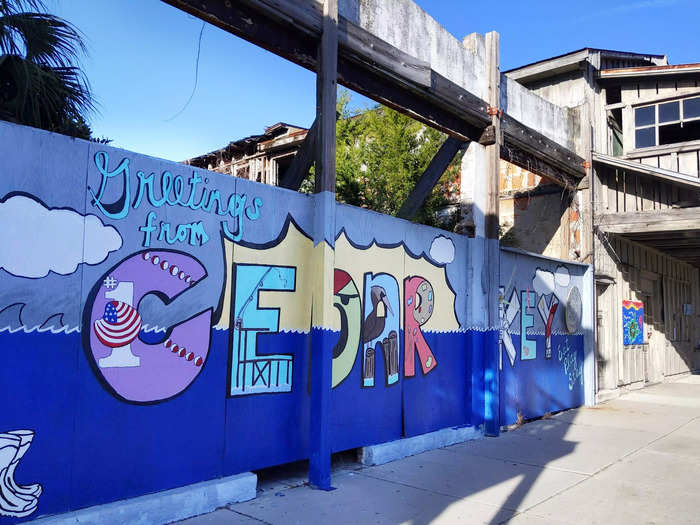
I've lived in Florida for two years but just discovered Cedar Key two hours from my house.Cheryl Rodewig

Settled in the 1840s, Cedar Key was once a busy shipping port and railroad town until a hurricane in 1896 ravaged the town and docks.
Today, the small town has only around 800 full-time residents, but in-the-know travelers seek it out for great seafood and laid back vibes.
When I visited with my husband for the first time earlier this year, I felt like I'd traveled back in time. There weren't any traffic jams, tourists taking selfies, or fancy hotels. Things moved at a slower pace, and I thought it was a welcome break from the bucket-list Florida vacations that come packed with things to see and do.
Here's a look around.

I moved to Florida at the start of the pandemic, settling near Tampa.
Cedar Key isn't that far away, just over two hours north of Tampa, but I lived here for nearly two years before making the trip.
I hadn't even heard of the island until someone mentioned it to me in passing. It's located off the beaten path, and the nearest big city, the college town of Gainesville, is over an hour away.
As a destination, it largely flies under the radar and locals I met like it that way.

On the last few miles of Florida State Road 24, I drove on a bridge across the water, past a tiki bar, fishing pier, and trail head to an old railroad trestle to reach the center of Cedar Key.
The island isn't large, just over 2 square miles, and I noticed that most people seemed to get around by golf cart or bicycle. There aren't any chain hotels like Marriott, either, just a few independently-owned motels and inns. Similarly, the businesses are all locally-owned, including plenty of fish markets. The nearest Walmart is 30 miles away.

I headed first to 2nd Street, the main thoroughfare of Cedar Key's three-block downtown, which runs about half a mile from one edge of the island to the other.
Strolling down the sidewalk, I passed the historical society museum, a visitor's center, and a handful of restaurants that are open year-round.
As I continued my walk, I noticed many of the buildings on 2nd Street were historic, often with second-story porches that I thought looked weathered from decades of exposure to the elements. Some even seemed abandoned to me.
I also saw a lot of art. I saw many art galleries and next to one was a pink and yellow painting of a sunset brightened a gray wall. Nearby, I spotted a tiled sculpture of a fisherman with a red tiled fish, perhaps created as a nod to the local fishing community.

Right off 2nd Street, the 1842 Daily Grind & Mercantile, named for the year the city was settled, grabbed my attention for its bright exterior alone. I didn't want to stop taking photos of the whimsical blend of purple, green, and orange topped with hand-lettered signs and blooming flowers.
I thought the cafe was just as quaint inside, with bric-a-brac and eclectic seating. A record player was spinning tunes and local goods for sale were scattered about.
As I ordered coffee, my barista told me the weather during my visit was perfect for windsurfing, as it's a popular local activity.
Sitting outside with my drink and egg sandwich, I watched people walk by. They seemed to be mostly locals, a few tourists, and no one rushing anywhere. The town felt peaceful, relaxed, like a lazy Sunday morning.

I saw plenty of local art in Cedar Key.
One gallery sign with a painted mermaid caught my eye, and I stepped inside. The Cedar Keyhole was founded in 1977, and features work from 25 artists.
I loved the variety of pieces, including a plethora of seashells, mermaids, and beach scenes. They had everything from paintings and jewelry to leather goods and glassware. The second floor houses the Cedar Key Arts Center with even more creativity on display.

The Island Hotel, built circa 1860 as a general store, is also on 2nd Avenue.
The historic hotel has just 10 rooms, and is popular with travelers looking for a central stay; many couples also get married here, I was told.
I stopped in to see the Neptune Bar, where Jimmy Buffet was once a frequent visitor and performer. While no one famous sang during my visit, I did catch a glimpse of the mermaid mural behind the bar that dates back to 1948.

From downtown, I walked another block to Cedar Key's largest public beach, part of the city park off the corner of A Street and 2nd Street.
The sandy stretch isn't large, which locals told me they like as it keeps crowds away. I saw a few families cooling off in the water.

I passed at least a half dozen waterfront restaurants here, mostly serving seafood. There were also souvenir shops and bars with live music.
And as fishing is a popular pastime on Cedar Key, I noticed a row of anglers lined up on the pier, hanging out for the next big bite. The Cedar Key pier offers convenient access to deeper water where you can catch redfish, sheepshead, black drum and more.

The Cedar Key National Wildlife Refuge protects 13 islands. You can charter a boat in Cedar Key to reach the more remote islands or rent a kayak or canoe to paddle to Atsena Otie, the nearest key, just a half mile (20 minutes) away.
But in my opinion, you don't need to leave Cedar Key for excellent birdwatching. I saw plenty of seabirds on my visit, no binoculars needed, just walking by the pier and parks. Egrets, herons, ospreys, even the elusive roseate spoonbill visit the island.

If you can't kayak the mangroves, walk through them. Mangrove trees thrive in swamp-like coastal habitats, and seeing them is an essential Florida activity.
Cemetery Point Park, just a mile from downtown, features a boardwalk that stretches 1,200 feet into a maze of mangroves. I found it too hot to do the whole walk, but I enjoyed the view points along the water and the solitude. The mangroves don't provide shade, so be sure to bring sunscreen.

Like most things on the island, Cedar Key Museum State Park isn't big, at least as far as state parks go, but its 18 acres are worth exploring and the $2 entry fee is a bargain.
In the museum, I browsed exhibits on the island's history, Native American artifacts, and a robust shell collection. Outside, I walked through pine and palmetto trees, past salt marshes, and open water.

When researching Cedar Key, I found most people recommended catching the sunset outside the Beach Front Motel near the corner of G Street and 1st Street.
I checked it out but ultimately found a better view from Dock Street. Stand near the pier where pelicans perch atop dilapidated wooden pilings, and be ready with your camera. I think it's the best show in town.

What I love about Cedar Key is that it is a place where I didn't have to plan my visit at all.
The no-rush, no-crowds charm of Cedar Key is part of why people sometimes call it the Key West of 50 years ago and I totally agree.
Mostly, I wandered around and enjoyed the scenery. Pretty much everything is walking distance — I walked from downtown to Dock Street in less than two minutes — and I never had to deal with hordes of tourists like I might in more popular Florida destinations.
It's a hidden gem, and I hope it always stays that way.
 Stock markets stage strong rebound after 4 days of slump; Sensex rallies 599 pts
Stock markets stage strong rebound after 4 days of slump; Sensex rallies 599 pts
 Sustainable Transportation Alternatives
Sustainable Transportation Alternatives
 10 Foods you should avoid eating when in stress
10 Foods you should avoid eating when in stress

Copyright © 2024. Times Internet Limited. All rights reserved.For reprint rights. Times Syndication Service.